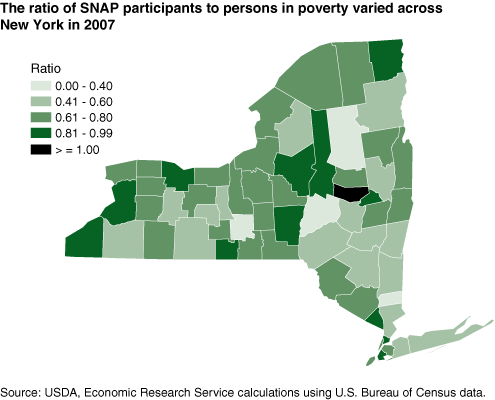State Participation-To-Poverty Rates for SNAP Mask County-Level Variation
- by John A. Kirlin
- 12/1/2010
USDA’s Supplemental Nutrition Assistance Program (SNAP, formerly named the Food Stamp Program) is the Nation’s largest food and nutrition assistance program, providing $50.4 billion in assistance in fiscal year 2009 to a monthly average of 33.7 million people. To be eligible for SNAP benefits, households must meet income guidelines, asset limits, and certain work and immigration status requirements.
One of the primary measures of the program’s performance is the rate at which individuals who are eligible for the program participate. Calculating this rate is difficult because counts of individuals eligible but not receiving SNAP benefits are not readily available. Estimates of participation rates have been made at the State level, but State estimates can mask variation among counties. Information about county-level participation rates can help local governments assess if their populations are adequately served by the program.
To address this information gap, ERS researchers used Census Bureau data on SNAP participation and the number of people in poverty to calculate county-level “participation-to-poverty” (PTP) rates. High PTP rates mean that more of the people who are likely to be eligible for SNAP benefits are receiving them. Low rates could indicate the need for better outreach about the program to low-income residents, including providing improved information about the program or assistance with applications.
Based on data from 2007 (the latest year for which published county-level data on both program participation and poverty counts are available), the PTP rate was 0.73 nationally—the number of SNAP participants equaled 73 percent of the number of individuals in poverty. The State with the highest overall PTP rate that year was Maine with a rate of 1.09, while Colorado had the lowest rate at 0.45. New York’s PTP rate of 0.73 matched the national rate, but there was a great deal of variation at the county level, as in most States. Montgomery County in east-central New York had the highest PTP rate (1.20) in the State, whereas adjacent Otsego, nearby Hamilton, and two other counties had PTP rates at or below 0.40.
The ratios that exceed 1.0 reflect that the PTP rate is not a perfect measure of the proportion of eligible residents participating in SNAP. Census poverty data are based on gross income measures, and households with gross incomes greater than the poverty level can be eligible for SNAP if their net incomes (gross income minus program-allowed deductions for earnings, housing, and other expenses) are below the poverty level and they meet other eligibility provisions. It is also possible for individuals with gross income below the poverty level to be ineligible because their assets are too high.
This article is drawn from:
- Supplemental Nutrition Assistance Program (SNAP) Data System. (n.d.). U.S. Department of Agriculture, Economic Research Service.
We’d welcome your feedback!
Would you be willing to answer a few quick questions about your experience?


